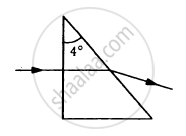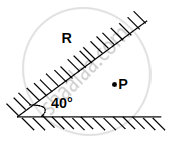Advertisements
Advertisements
Question
a) Give two reasons to explain why reflecting telescopes are preferred over refracting type.
Solution
(a) The reflecting telescopes are preferred over refracting type because of the following reasons:
(i) There is no chromatic aberration in case of reflecting telescopes as the objective is a mirror.
(ii) Spherical aberration is reduced in case of reflecting telescopes by using mirror objective in the form of a paraboloid.
APPEARS IN
RELATED QUESTIONS
Use the mirror equation to deduce that an object placed between the pole and focus of a concave mirror produces a virtual and enlarged image.
Using mirror formula, explain why does a convex mirror always produce a virtual image.
The rays of different colours fail to converge at a point after going through a converging lens. This defect is called
Which of the following (referred to a spherical mirror) do (does) not depend on whether the rays are paraxial or not?
(a) Pole
(b) Focus
(c) Radius of curvature
(d) Principal axis
A light ray is incident normally on the face AB of a right-angled prism ABC (μ = 1.50) as shown in figure. What is the largest angle ϕ for which the light ray is totally reflected at the surface AC?

Find the angle of deviation suffered by the light ray shown in figure. The refractive index μ = 1.5 for the prism material.

A light ray, going through a prism with the angle of prism 60°, is found to deviate by 30°. What limit on the refractive index can be put from these data?
Name the physical principle on which the working of optical fibers is based.
For paraxial rays, show that the focal length of a spherical mirror is one-half of its radius of curvature.
Two plane mirrors are inclined at an angle of 40°. The possible number of images of an object placed at point P would be?

